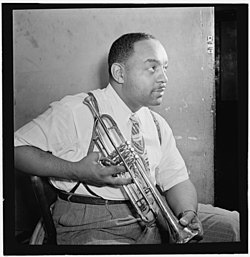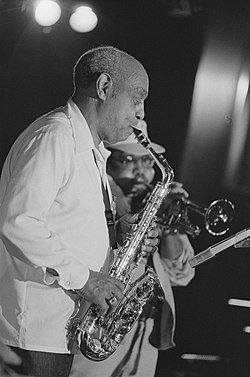
SOUND PROJECTIONS
AN ONLINE QUARTERLY MUSIC MAGAZINE
EDITOR: KOFI NATAMBU
WINTER, 2020
VOLUME EIGHT NUMBER ONE
HERBIE HANCOCK
Featuring the Musics and Aesthetic Visions of:
MELBA LISTON
(November 30-December 6)
KENNY CLARKE
(December 7-13)
LEONTYNE PRICE
(December 14-20)
JIMMY LYONS
(December 21-27)
PATRICE RUSHEN
(December 28-January 3)
ELVIN JONES
(January 4-10)
GARY BARTZ
(January 11-17)
HALE SMITH
(January 18-24)
BENNY CARTER
(January 25-31)
BENNY GOLSON
(February 1-7)
BENNY BAILEY
(February 8-14)
SKIP JAMES
Benny Carter
(1907-2003)
Artist Biography by Scott Yanow
To say that Benny Carter
had a remarkable and productive career would be an extreme
understatement. As an altoist, arranger, composer, bandleader, and
occasional trumpeter, Carter was at the top of his field since at least 1928, and in the late '90s, Carter
was as strong an altoist at the age of 90 as he was in 1936 (when he
was merely 28). His gradually evolving style did not change much through
the decades, but neither did it become at all stale or predictable
except in its excellence. Benny Carter
was a major figure in every decade of the 20th century since the 1920s,
and his consistency and longevity were unprecedented.
Essentially self-taught, Benny Carter started on the trumpet and, after a period on C-melody sax, switched to alto. In 1927, he made his recording debut with Charlie Johnson's Paradise Ten. The following year, he had his first big band (working at New York's Arcadia Ballroom) and was contributing arrangements to Fletcher Henderson and even Duke Ellington. Carter was with Henderson during 1930-1931, briefly took over McKinney's Cotton Pickers,
and then went back to leading his own big band (1932-1934). Already at
this stage he was considered one of the two top altoists in jazz (along
with Johnny Hodges),
a skilled arranger and composer ("Blues in My Heart" was an early hit
and would be followed by "When Lights Are Low"), and his trumpet playing
was excellent; Carter
would also record on tenor, clarinet (an instrument he should have
played more), and piano, although his rare vocals show that even he was
human.
In 1935, Benny Carter
moved to Europe, where in London he was a staff arranger for the BBC
dance orchestra (1936-1938); he also recorded in several European
countries. Carter's
"Waltzing the Blues" was one of the very first jazz waltzes. He
returned to the U.S. in 1938, led a classy but commercially unsuccessful
big band (1939-1941), and then headed a sextet. In 1943, he relocated
permanently to Los Angeles, appearing in the film Stormy Weather (as a
trumpeter with Fats Waller)
and getting lucrative work writing for the movie studios. He would lead
a big band off and on during the next three years (among his sidemen
were J.J. Johnson, Miles Davis, and Max Roach) before giving up on that effort. Carter
wrote for the studios for over 50 years, but he continued recording as
an altoist (and all-too-rare trumpeter) during the 1940s and '50s,
making a few tours with Jazz at the Philharmonic and participating on
some of Norman Granz's jam-session albums. By the mid-'60s, his writing
chores led him to hardly playing alto at all, but he made a full
"comeback" by the mid-'70s, and maintained a very busy playing and
writing schedule even at his advanced age. Even after the rise of such
stylists as Charlie Parker, Cannonball Adderley, Eric Dolphy, Ornette Coleman, and David Sanborn (in addition to their many followers), Benny Carter
still ranks near the top of alto players. His concert and recording
schedule remained active through the '90s, slowing only at the end of
the millenium. After eight amazing decades of writing and playing, Benny Carter passed away quietly on July 13, 2003 at a Los Angeles hospital. He was 95.
Benny Carter, 95, Musician and Arranger Who Shaped 8 Decades of Jazz, Dies
by John S. Wilson
Benny
Carter, whose combination of highly developed talents as composer,
arranger, bandleader and soloist on a variety of instruments was
unmatched in the jazz world, died Saturday at a hospital in Los Angeles.
He was 95.
A Versatile Master
Benny
Carter's career was remarkable for both its length and its consistently
high musical achievement, from his first recordings in the 1920's to
his youthful-sounding improvisations in the 1990's. His pure-toned,
impeccably phrased performances made him one of the two pre-eminent alto
saxophonists in jazz, with Johnny Hodges, from the late 1920's until
the arrival of Charlie Parker in the mid-1940's. He was also an
accomplished soloist on trumpet and clarinet, and on occasion he played
piano, trombone and both tenor and baritone saxophones.
He
helped to lay the foundation for the swing era of the late 1930's and
early 40's with arrangements he had written a decade earlier for his own
big band and the orchestras of Fletcher Henderson and Chick Webb, as
well as for Benny Goodman before Goodman was acclaimed as the King of
Swing. He later contributed arrangements and compositions to Glenn
Miller and Count Basie.
From 1929 to
1946, Mr. Carter led big bands sparkling with young talent. His band in
the early 1930's included the pianist Teddy Wilson, the saxophonist Chu
Berry, the trombonist J. C. Higginbotham and the drummer Sid Catlett. A
decade later, his contingent of future jazz stars included the
trombonists J. J. Johnson and Al Grey, the trumpeter Miles Davis and the
drummer Max Roach.
His compositions
included ''Blues in My Heart,'' ''When Lights Are Low,'' ''Blue Star,''
''Lonesome Nights,'' ''Doozy'' and ''Symphony in Riffs.'' Beginning in
the early 1940's, he composed and orchestrated music for films, and from
the late 50's he also composed for television.
In
1962, when Mr. Carter was only 54, the critic Whitney Balliett wrote in
The New Yorker that ''few of his contemporaries continue to play or
arrange or compose as well as he does, and none of them plays as many
instruments and arranges and composes with such aplomb.''
''Carter,
indeed, belongs to that select circle of pure-jazz musicians who tend
to represent the best of their times,'' the piece continued.
His
public fame did not always match his accomplishments, and his only
major hit of the big band era was ''Cow-Cow Boogie,'' a novelty tune
sung by Ella Mae Morse. However, early in his career his fellow
musicians nicknamed him simply the King, and among them he was held in
universally high regard.
The trumpeter
Doc Cheatham recalled that ''we broke our backs to get into Benny's
band'' because musicians learned so much from performing with him. Sy
Oliver, whose brilliant arrangements gave the Jimmie Lunceford orchestra
of the 1930's and the Tommy Dorsey band of the 1940's their distinctive
cachet, said Mr. Carter was ''the most complete professional musician
I've ever known.''
And John Hammond,
the record producer who nurtured the careers of Count Basie, Billie
Holiday and Benny Goodman, said Mr. Carter was ''one of the great
influences in American music, one of its unsung heroes.''
Mr.
Carter was not widely known to the jazz public until his emergence, in
his 70's, as an acclaimed elder statesman. His lack of public
recognition was sometimes attributed to the fact that his bearing was
reserved and dignified, that he was not a flamboyant showman. Moreover,
as the drummer J. C. Heard suggested, ''his music was a little too
refined'' for the 1930's and 40's, when he was leading a big band.
Bennett
Lester Carter was born on Aug. 8, 1907, the youngest of three children
and the only boy. He was reared in a neighborhood called San Juan Hill,
then one of the roughest areas in Manhattan, near what is now Lincoln
Center.
When he was a youngster, his
musical idols were trumpeters -- his cousin Theodore (Cuban) Bennett,
who never recorded but whose advanced musical ideas were attested to by
many musicians, and Bubber Miley, a star of Duke Ellington's orchestra
in the late 1920's who lived around the corner.
When
he was 13, he bought a trumpet at a pawnshop, but when he was unable to
play it after a weekend of effort he traded it in for a saxophone.
By
the time he was 15, he was sitting in with bands in Harlem. He got his
first full-time job when he was 19, with Charlie Johnson's band at
Smalls' Paradise in Harlem.
When he made his first records in 1928, with the Johnson band, the session included two of his own arrangements.
Also
in 1928, he joined a band led by Fletcher Henderson's brother, Horace,
and shortly after, when the leader walked out during a tour, the
abandoned musicians elected Mr. Carter to replace him. He was 21 years
old. For the next two decades, as his biographer, Morroe Berger, wrote,
''he was either leading a band or regretfully disbanding one while
looking forward to organizing another one.''
In
1935, Mr. Carter went to Paris to join the Willie Lewis Orchestra at
the club Chez Florence. He remained in Europe for three years, playing
mostly in France, Denmark and the Netherlands. He also spent 10 months
in England as an arranger for the British Broadcasting Corporation dance
orchestra.
On his return to the
United States in 1938, Mr. Carter formed another big band, which played
at the Savoy Ballroom for two years. After that band broke up, Mr.
Carter led a small group on 52nd Street while he wrote arrangements for
the radio show ''Your Hit Parade'' and prepared still another band. He
then headed toward the West Coast on tour and settled in Hollywood.
He
began his association with films in 1943 with ''Stormy Weather,'' for
which he wrote arrangements and played on the soundtrack but received no
screen credit.
From 1946 until 1970,
he was virtually out of the public eye. Aside from a few tours with the
all-star Jazz at the Philharmonic troupe in the 1950's, he stayed behind
the scenes as a composer, arranger and occasional instrumentalist in
films and, starting in 1959, in television.
In Hollywood, he
was one of the first black arrangers to break the color barrier, working
on top television series like ''M Squad.'' He also arranged music for
almost every major singer of the day, including Billie Holiday, Ella
Fitzgerald, Sarah Vaughan, Lou Rawls, Ray Charles, Peggy Lee, Louis
Armstrong, Pearl Bailey, Billy Eckstine and Mel Tormé.
In
1969, Dr. Berger, who taught sociology at Princeton University and had
written his master's thesis on jazz, persuaded Mr. Carter to join him at
Princeton for a weekend of seminars, classes and a campus concert. Over
the next nine years, Mr. Carter made five visits to Princeton, staying
briefly each time except in 1973, when he stayed for a semester as a
visiting professor. In 1974, he received an honorary Master of
Humanities degree from Princeton.
In
the 1970's, Mr. Carter's new academic career revived his playing career.
In 1975, he made a tour of the Middle East under the auspices of the
State Department, and in 1976 he appeared in a New York City nightclub
for the first time since 1942. He made dozens of new albums over the
next two decades and saw much of his early work reissued in collections.
He continued to perform in the smallest clubs and the largest concert
halls in the the United States, Europe and Japan through the 1990's.
Mr.
Carter's arranging skills were largely self-taught, and the results
echoed his instantly recognizable sound as a soloist, especially on alto
sax. One of his trademarks was the sound of four saxophones in
intricate harmony, playing one of his swooping, looping melodic passages
as if they were a single instrument improvising.
His
sound can be heard to good advantage in two of his most famous
recordings: the 1937 ''Honeysuckle Rose,'' made in Europe with an
international group including Coleman Hawkins and Django Reinhardt, and
the 1961 reprise of the same tune on the album ''Further Definitions.''
That album seamlessly bridged the worlds of swing and bebop by joining
old masters like Hawkins with young turks like Phil Woods and Charlie
Rouse and is considered one of the most influential jazz recordings.
Mr.
Carter recalled how he learned arranging in a 1987 interview with Gary
Giddins. Starting with all the parts of a commercial stock arrangement,
he said, ''you lay them piece by piece on the floor, and you get down on
your knees and you study each part, and then you start writing the lead
trumpet first and the lead saxophone first -- which, of course, is
really the hard way.'' It was quite some time before he knew what a
score was, he said, ''and of course after you know how to make a score,
well, you know the score.''
Carter
arrangements and compositions, old and new, stayed in the books of
groups like the Count Basie Orchestra and the Lincoln Center Jazz
Orchestra into the 1990's. By 1987 there were more than 50 recorded
versions of just one of his tunes, ''Blues in My Heart.'' In the 1990's,
the Basie band, then led by Grover Mitchell, was still playing excerpts
from his 1960 ''Kansas City Suite'' at almost every performance.
In
1996, he was one of five recipients of the Kennedy Center Honors in
Washington, and in 2000, he received the National Medal of Arts from
President Bill Clinton.
When Mr.
Carter turned 90, in 1997, the occasion was observed with a concert
tribute two days before his birthday at the Hollywood Bowl; it could not
be held on his actual birthday because by then he was in Oslo to give a
concert.
A musician whose recording
career extended from the 78 era through LP's and well into the time of
CD's, Benny Carter lived to see his own Web site, designed by the
scholars Ed and Laurence Berger, sons of Morroe Berger, his biographer,
at www.bennycarter.com.
Mr. Carter was
married five times. His first wife, whom he married in 1925 when he was
18, died of pneumonia three years later. Three of his marriages ended
in divorce. In 1979, he married Hilma Ollila Arons, who survives him,
along with a daughter, Joyce Mills, a granddaughter and a grandson. He
met Ms. Arons in 1940, when she and her sister went to the Savoy
Ballroom in Harlem to hear his band.
A version of this article appears in print on , Section B, Page 7 of the National edition with the headline: Benny Carter, 95, Musician and Arranger Who Shaped 8 Decades of Jazz, Dies. Order Reprints | Today’s Paper
3 Things to Know About Benny Carter, an Unsung Champion of Jazz
Benny Carter
Bennett Lester Carter (August 8, 1907 – July 12, 2003) was an American jazz saxophonist, clarinetist, trumpeter, composer, arranger, and bandleader. With Johnny Hodges,
he was a pioneer on the alto saxophone. From the beginning of his
career in the 1920s he was a popular arranger, having written charts for
Fletcher Henderson's
big band that shaped the swing style. He had an unusually long career
that lasted into the 1990s. During the 1980s and '90s, he was nominated
for eight Grammy Awards, which included receiving a Lifetime Achievement
Award.
Career
Born in
New York City in 1907, he was given piano lessons by his mother and
others in the neighborhood. He played trumpet and experimented briefly
with C-melody saxophone before settling on alto saxophone. In the 1920s,
he performed with June Clark, Billy Paige, and Earl Hines, then toured as a member of the Wilberforce Collegians led by Horace Henderson.[1]
He appeared on record for the first time in 1927 as a member of the Paradise Ten led by Charlie Johnson.[2] He returned to the Collegians and became their bandleader through 1929, including a performance at the Savoy Ballroom in New York City.[1]
In his early 20s, Carter worked as arranger for Fletcher Henderson after that position was vacated by Don Redman.
He had no formal education in arranging, so he learned by trial and
error, getting on his knees and looking at the existing charts, "writing
the lead trumpet first and the lead saxophone first—which, of course,
is the hard way. It was quite some time that I did that before I knew
what a score was."[3]
He left Henderson to take Redman's former job as leader of McKinney's Cotton Pickers in Detroit. In 1932 he formed a band in New York City that included Chu Berry, Sid Catlett, Cozy Cole, Bill Coleman, Ben Webster, Dicky Wells, and Teddy Wilson.[1]
Carter's arrangements were complex. Among the most significant were
"Keep a Song in Your Soul", written for Henderson in 1930, and "Lonesome
Nights" and "Symphony in Riffs" from 1933, both of which show Carter's
writing for saxophones.[4]
By the early 1930s, Carter and Johnny Hodges
were considered the leading alto saxophonists. Carter also became a
leading trumpet soloist, having rediscovered the instrument. He recorded
extensively on trumpet in the 1930s. Carter's short-lived Orchestra
played the Harlem Club in New York but only recorded a handful of
records for Columbia, OKeh and Vocalion. The OKeh sides were issued under the name The Chocolate Dandies.
Carter stands with Robert Goffin, Louis Armstrong, and Leonard Feather in 1942.
In 1933 Carter participated in sessions with British band leader Spike Hughes,
who went to New York City to organize recordings with prominent African
American musicians. These 14 sides plus four by Carter's big band,
titled at the time Spike Hughes and His Negro Orchestra, were initially only issued in England. The musicians were from Carter's band and included Red Allen, Dicky Wells, Wayman Carver, Coleman Hawkins, J. C. Higginbotham, and Chu Berry.[5]
Carter moved to London and spent two years as arranger for the BBC Big Band.[2]
In England, France, and Scandinavia he recorded with local musicians,
and he took his band to the Netherlands. In these settings Carter played
trumpet, clarinet, piano, alto and tenor saxophone, and provided
occasional vocals.[1]
In 1938 he returned to America. He found regular work leading his band
at the Savoy Ballroom in Harlem through 1941. The band included Shad Collins, Sidney De Paris, Vic Dickenson, and Freddie Webster. After this engagement he led a seven-piece band which included Eddie Barefield, Kenny Clarke, and Dizzy Gillespie.
Portrait of Benny Carter,ApolloTheatre, New York City, c. October 1946
In the middle 1940s, he made Los Angeles his home, forming another big band, which at times included J. J. Johnson, Max Roach, and Miles Davis. But these would be his last big bands. With the exception of occasional concerts, performing with Jazz at the Philharmonic,[3]
and recording, he ceased working as a touring big band bandleader. Los
Angeles provided him many opportunities for studio work, and these
dominated his time during the decades. He wrote music and arrangements
for television and films, such as Stormy Weather in 1943. During the 1950s and '60s, he wrote arrangements for vocalists[3] such as Louis Armstrong, Ray Charles, Ella Fitzgerald, Peggy Lee, and Sarah Vaughan.[1] On something of a comeback in the 1970s,[2]
Carter returned to playing saxophone again and toured the Middle East
courtesy of the U.S. State Department. He began making annual visits to
Europe and Japan.[1]
Carter performs at the North Sea Jazz Festival in 1985.
In 1969, Carter was persuaded to spend a weekend at Princeton
University by Morroe Berger, a sociology professor at Princeton who
wrote about jazz. This led to a new outlet for Carter's talent:
teaching. For the next nine years he visited Princeton
five times, most of them brief stays except for one in 1973 when he
spent a semester there as a visiting professor. In 1974 Princeton gave
him an honorary doctorate.[1]
He conducted teaching at workshops and seminars at several other
universities and was a visiting lecturer at Harvard for a week in 1987.
Morroe Berger wrote Benny Carter – A Life in American Music (1982), a two-volume work about Carter's career.[6]
Time had little effect on Carter's abilities. During the 1980s he wrote the long composition Central City Sketches which was performed at Cooper Union by the American Jazz Orchestra. Another long composition, Glasgow Suite,
was performed in Scotland. Lincoln Center commission him to write "Good
Vibes" in 1990. The National Endowment for the Arts gave him a grant
that led Tales of the Rising Sun Suite and Harlem Renaissance Suite. This music was performed in 1992 when he was 85 years old.[3]
Carter had an unusually long career. He was perhaps the only musician to have recorded in eight different decades.[2]
Another characteristic of his career was its versatility as musician,
bandleader, arranger, and composer. He helped define the sound of alto
saxophone, but he also performed and recorded on soprano saxophone,
tenor saxophone, trumpet, trombone, clarinet, and piano.[3]
He helped establish a foundation for arranging as far back as 1930 when
he arranged "Keep a Song in Your Soul" for Fletcher Henderson's big
band. His compositions include the novelty hit "Cow-Cow Boogie" recorded by Ella Mae Morse, and the expansive Central City Sketches, written when he was 80 years old and recorded with the American Jazz Orchestra.[1]
Carter died at the age of 95 in Los Angeles at Cedars-Sinai Medical Center on July 12, 2003 from complications of bronchitis.[7][8]
On June 25, 2019, The New York Times Magazine listed Benny Carter among hundreds of artists whose material was reportedly destroyed in the 2008 Universal fire.[9]
Awards and honors
He was inducted into the Down Beat Jazz Hall of Fame in 1977. In 1978, he was inducted into the Black Filmmakers Hall of Fame.[10] In 1980 he received the Golden Score award of the American Society of Music Arrangers and Composers. His 75th birthday was commemorated by a radio station in New York that played his music nonstop for over a week.[1] The National Endowment for the Arts gave him the NEA Jazz Masters Award for 1986.[11]
He was given a Grammy Lifetime Achievement Award in 1987. In 1994 he won a Grammy Award for his solo on "Prelude to a Kiss" and received a star on the Hollywood Walk of Fame.
In 1989 Lincoln Center celebrated Carter's 82nd birthday with a set of his songs sung by Ernestine Anderson and Sylvia Syms. In 1990, he was named Jazz Artist of the Year in the Down Beat and JazzTimes polls. He was a Kennedy Center Honoree in 1996 and received honorary doctorates from Princeton (1974),[12] Rutgers (1991),[13] Harvard (1994), and the New England Conservatory of Music (1998).[14] In 2016 the National Museum of American History made Carter the subject of its Jazz Appreciation Month poster.[15]
In 2000, he was given the National Medal of Arts by President Bill Clinton.[16][17]
Grammy Awards
- Wins: 3
- Nominations: 9[18]
Discography
Information from AllMusic.com[19]
As arranger
As sideman
With Louis Bellson
- Skin Deep (Norgran, 1953)
With Dizzy Gillespie
- The Complete RCA Victor Recordings (Bluebird, 1937–1949, [1995])
- The Drum Battle (Verve, 1952 [1960])
With Peggy Lee
- Blues Cross Country (Capitol, 1962) -- also some arrangements
With Dave Pell
- I Remember John Kirby (Capitol, 1961)
With Nancy Wilson
- The Sound of Nancy Wilson (Capitol, 1968)
- Nancy (Capitol, 1969)
Songs composed by Carter
- "Blues in My Heart" (1931) with Irving Mills
- "When Lights Are Low" (1936) with Spencer Williams
- "Cow-Cow Boogie (Cuma-Ti-Yi-Yi-Ay)" (1942) with Don Raye and Gene De Paul
- "Key Largo" (1948) with Karl Suessdorf, Leah Worth
- "Rock Me to Sleep" (1950) with Paul Vandervoort II
- "A Kiss from You" (1964) with Johnny Mercer
- "Only Trust Your Heart" (1964) with Sammy Cahn
Film and video
- Thousands Cheer (1943)
- An American in Paris (1951)
- Clash by Night (1952)
- The Snows of Kilimanjaro (1952)
- Jazz at the Smithsonian: Benny Carter (1982)
- Benny Carter in Japan (1986)
- Wolf Trap Salutes Dizzy Gillespie (1988)
- Benny Carter: Symphony in Riffs (1989)[1]
See also
External links
Benny's Music Class, Audio clips at the National Museum of American History web site
- Benny Carter: "Souvenir of Benny" by Alex Henderson, The New York City Jazz Record
- Benny Carter Audio Collection, Institute of Jazz Studies, Dana Library, Rutgers University, Newark, New Jersey
- Benny Carter Interview NAMM Oral History Library (1994)
https://www.billboard.com/articles/news/69995/jazz-great-benny-carter-dead-at-95

Legendary jazz pioneer and big band leader Benny Carter, who helped
break Hollywood's bar to black composers, died Saturday at Cedars Sinai
hospital in Los Angeles. He was 95. Carter, who was one of the first
black composers and arrangers to work on mainstream Hollywood films,
including such classics as "Stormy Weather," had been hospitalized for
about two weeks, complaining of bronchitis and fatigue, said family
friend Virginia Wicks.
"If Benny was
not there, we wouldn't be here," said composer and arranger Quincy
Jones, a close friend and protege. "We walked through the door on his
shoulders. He was a quiet and dignified man. And one of a kind."
In
a career that spanned seven decades, Carter played with such jazz
luminaries as pianist Willie "The Lion" Smith, Fats Waller, Miles Davis
and Dizzie Gillespie. He is also credited with launching Ella
Fitzgerald's career by introducing her to bandleader Chick Webb.
Carter's compositions, including "Blues in My Heart" and "When Lights
Are Low," have become jazz standards.
A
largely self-taught musician, Carter established the swing-era, big
band sound through ensemble compositions for the Fletcher Henderson
orchestra and later his own band.
Born
in 1907 in New York, Carter studied piano with his mother and was
inspired by his neighbor, Bubber Miley, a musician with Duke Ellington's
band. He began sitting in at Harlem night spots at the age of 15,
having left school. By 1928, he was recording with Henderson's band and
is credited with groundbreaking arrangements like "Keep a Song in Your
Soul."
Carter applied the principles
of the jazz solo to whole sections of the orchestra in a way that made
them swing as they never had before, according to biographer Ed Berger.
As a result, the major big bands at the peak of their popularity in the
1930s sought him out and his own orchestra attracted a who's who of jazz
musicians, including such sidemen as saxophonist Chu Berry and pianist
Teddy Wilson.
In 1941, he formed a sextet that included such bebop pioneers as trumpeter Dizzy Gillespie and drummer Kenny Clarke. Known as a courtly and patient mentor, Carter nurtured some of the next generation's major stars in jazz.
In 1941, he formed a sextet that included such bebop pioneers as trumpeter Dizzy Gillespie and drummer Kenny Clarke. Known as a courtly and patient mentor, Carter nurtured some of the next generation's major stars in jazz.
Carter
was also a pioneer in breaking down color barriers for black musicians
and composers. He formed the first international and interracial band in
the Netherlands in the mid-1930s and a decade later became one of the
first black composers to work in film and television.
A
self-effacing and private man, Carter was modest about his
accomplishments. "No one was ever more articulate than Benny Carter --
except about himself," said Berger. "He would not admit that this was
any great, earth-shattering thing. To him it was just another gig."
Carter is survived by his wife, Hilma, a daughter, Joyce Mills, a grandchild and a great grandchild, said Wicks.
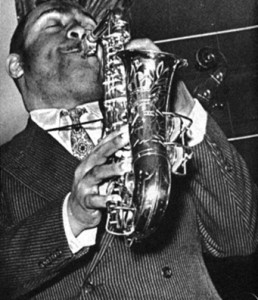
Riverwalk Jazz recalls the nine decade career of
saxophonist, trumpeter, composer and arranger Benny Carter with music
and memories from the maestro himself; and an interview with Ed Berger,
Associate Director of the Institute of Jazz Studies at Rutgers
University. Berger was Carter's road manager and one of the authors of
the definitive biography, Benny Carter: A Life in American Music.
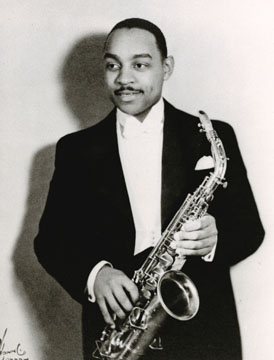
A pioneering jazzman whose career began in the 1920s Benny Carter
played the saxophone, trumpet, clarinet and piano. He was an influential
composer and arranger, and is widely considered an "Architect of the
Swing Era sound." Benny Carter was one of the first African-Americans to
write music for movies and television soundtracks, and became a role
model for others in that field.
Benny Carter grew up in the tough Manhattan neighborhood of San Juan Hill. By age fifteen Carter was sitting-in at Harlem night spots. As a boy Carter wanted to play trumpet like his hero Bubber Miley, then switched to saxophone, thinking it would be the easier instrument to master. Carter would go on to master both trumpet and saxophone, and he played both instruments throughout is life.
By 1928 at the age of 20, Benny had mastered the craft of writing arrangements for jazz bands. He was hired by top band leader Fletcher Henderson and swiftly became the most influential jazz arranger in New York. He also made his first recording that year. By the 1930s he was performing and writing music in Europe and America for his own bands and those of Benny Goodman, Count Basie, Duke Ellington, Glenn Miller, Gene Krupa and Tommy Dorsey.
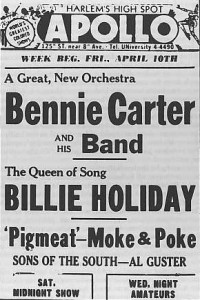
Carter's first successful score for a Hollywood movie was Stormy Weather,
in 1943. Thereafter, Benny spent much of his time scoring films and TV
shows. He continued to write jazz arrangements and to perform
brilliantly on alto saxophone and trumpet well into his 90s.
Featured this week are rare recordings of Benny Carter live with The Jim Cullum Jazz Band in a 1992 Riverwalk Jazz appearance on stage at The Landing. Carter performs music with Jim and the band that he created many decades earlier, including his famous standards, "When Lights are Low" and "Blues in My Heart." Carter also presents more recent compositions, like his "People Time."
Photo credit for Home Page: Jim Cullum, Ed Torres and Benny Carter. Photo courtesy Riverwalk Jazz.
Program : 296
When Lights Are Low: A Conversation with Benny Carter Biographer Ed Berger

Benny Carter. Photo courtesy Rutgers University Institute of Jazz Studies.
BONUS PHOTO GALLERY
Musicians respectfully called Carter, “The King,” and considered it an honor to perform in his bands, even when there was little or no pay. Jazz artists knew they would be surrounded by the best players in Benny Carter's groups, and that his music would be challenging and exciting.
Benny Carter, 1936. Photo courtesy Rutgers Univ. Institute of Jazz Studies.
Benny Carter grew up in the tough Manhattan neighborhood of San Juan Hill. By age fifteen Carter was sitting-in at Harlem night spots. As a boy Carter wanted to play trumpet like his hero Bubber Miley, then switched to saxophone, thinking it would be the easier instrument to master. Carter would go on to master both trumpet and saxophone, and he played both instruments throughout is life.
By 1928 at the age of 20, Benny had mastered the craft of writing arrangements for jazz bands. He was hired by top band leader Fletcher Henderson and swiftly became the most influential jazz arranger in New York. He also made his first recording that year. By the 1930s he was performing and writing music in Europe and America for his own bands and those of Benny Goodman, Count Basie, Duke Ellington, Glenn Miller, Gene Krupa and Tommy Dorsey.

Ad for Benny Carter and His Band at the Apollo. Image courtesy Rutgers Univ. Institute of Jazz Studies.
Featured this week are rare recordings of Benny Carter live with The Jim Cullum Jazz Band in a 1992 Riverwalk Jazz appearance on stage at The Landing. Carter performs music with Jim and the band that he created many decades earlier, including his famous standards, "When Lights are Low" and "Blues in My Heart." Carter also presents more recent compositions, like his "People Time."
Photo credit for Home Page: Jim Cullum, Ed Torres and Benny Carter. Photo courtesy Riverwalk Jazz.
Text based on Riverwalk Jazz script by Margaret Pick © 2012
Celebrating Benny Carter Photo Gallery
Images Courtesy Ed Berger,
Associate Director, Institute of Jazz Studies
Rutgers University
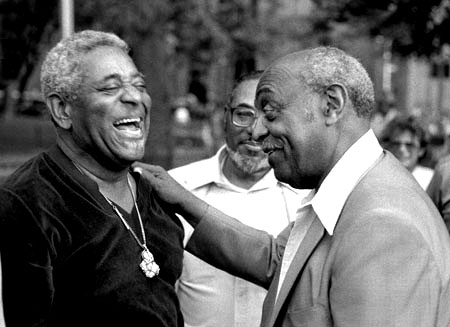
Dizzy Gillespie & Benny Carter c. 1984
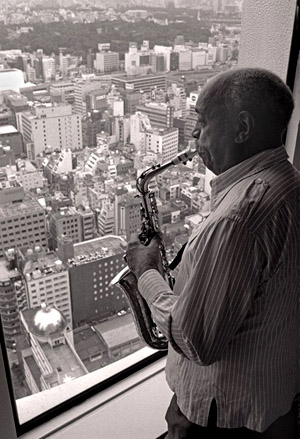
Rehearsing in a Tokyo hotel room c. 1988
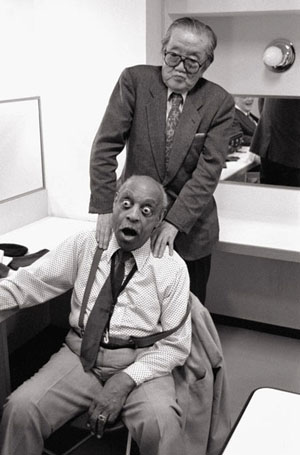
Backstage in Tokyo with jazz historian, Hisamitsu Noguchi c. 1991
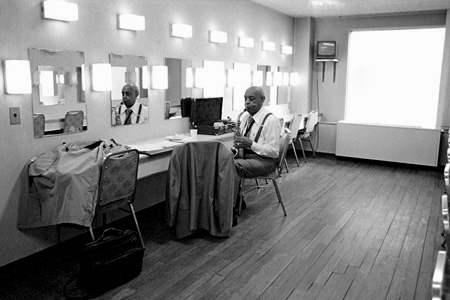
Backstage warm-up c. 1992
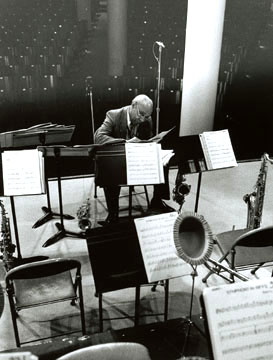
A quiet moment onstage c. 1991
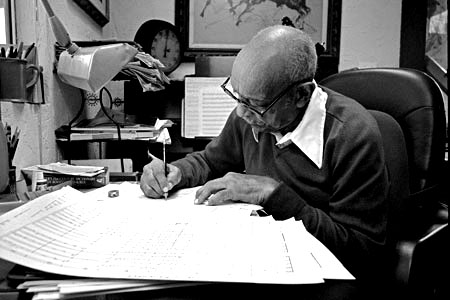
At home in Los Angeles c. 2000
THE MUSIC OF BENNY CARTER: AN EXTENSIVE VIDEO OVERVIEW, A CROSS SECTION OF RECORDINGS, MUSICAL ANALYSIS AND COMMENTARY, PLUS VARIOUS INTERVIEWS WITH BENNY CARTER:






